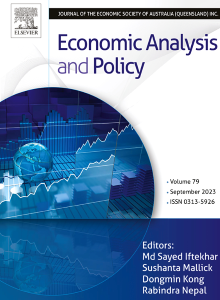Does public pension promote or inhibit enterprise total factor productivity? Evidence from China
IF 7.9
2区 经济学
Q1 ECONOMICS
引用次数: 0
Abstract
The relationship between pension contribution rates and productivity remains a significant topic of discussion. This study utilizes micro-level data to examine the interaction between statutory pension contribution rates, actual contribution rates, and the total factor productivity (TFP) of enterprises. The findings indicate that the reduction in the Basic Old-age Insurance contribution rate resulted in a 0.985 percentage point decline in actual contribution rates and 4.3 percentage point decline in TFP. Pension insurance contribution collection by tax authorities results in the highest collection intensity and lowest elasticity coefficient, while agency collection exhibits greater variability. Additionally, actual pension contribution rates and TFP exhibit an inverted U-shaped relationship. When the public pension contribution rate is either too high or too low, it may hinder improvements in enterprise production efficiency. Instead, there exists an optimal range of contribution rates where public pensions can foster a positive interaction between R&D investment, capital-skill substitution, and employee incentives. State-owned, labor-intensive, and low-wage firms experience sharper productivity declines beyond a lower optimal contribution rate, indicating that these firms reach peak productivity at lower contribution levels.
公共养老金是促进还是抑制企业全要素生产率?来自中国的证据
养老金缴费率与生产率之间的关系仍然是一个重要的讨论话题。本研究利用微观数据,考察了法定养老保险缴费率、实际缴费率与企业全要素生产率(TFP)之间的互动关系。研究结果表明,降低基本养老保险缴费率导致实际缴费率下降 0.985 个百分点,全要素生产率下降 4.3 个百分点。由税务机关征收养老保险费的征收强度最高,弹性系数最低,而代理征收的弹性系数较大。此外,养老金实际缴费率与全要素生产率呈现倒 U 型关系。当公共养老金缴费率过高或过低时,都会阻碍企业生产效率的提高。相反,存在一个最佳缴费率范围,在此范围内,公共养老金可以促进研发投资、资本-技能替代和员工激励之间的良性互动。国有企业、劳动密集型企业和低工资企业的生产率会在较低的最佳缴费率之后急剧下降,这表明这些企业在较低的缴费率水平上就能达到最高生产率。
本文章由计算机程序翻译,如有差异,请以英文原文为准。
求助全文
约1分钟内获得全文
求助全文
来源期刊

Economic Analysis and Policy
ECONOMICS-
CiteScore
9.80
自引率
9.20%
发文量
231
审稿时长
93 days
期刊介绍:
Economic Analysis and Policy (established 1970) publishes articles from all branches of economics with a particular focus on research, theoretical and applied, which has strong policy relevance. The journal also publishes survey articles and empirical replications on key policy issues. Authors are expected to highlight the main insights in a non-technical introduction and in the conclusion.
 求助内容:
求助内容: 应助结果提醒方式:
应助结果提醒方式:


